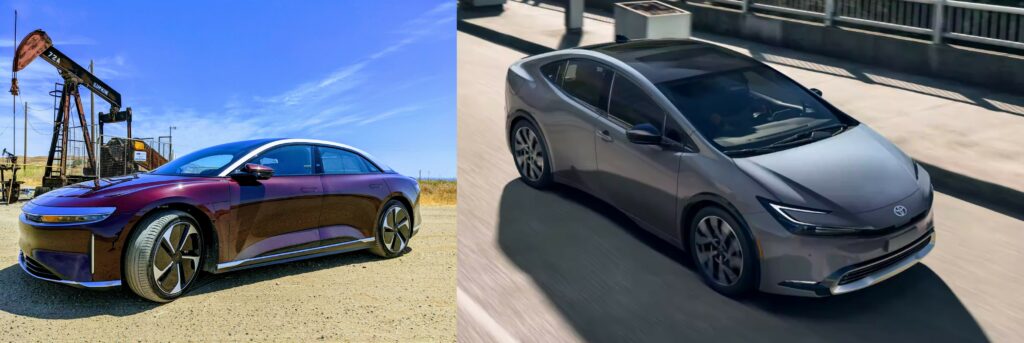TL;DR
A Plug-In Hybrid Electric Vehicle (or PHEV) can be a solid option for many EV buyers. In fact, it may be the only viable option for many would-be consumers. I understand the logic of “Please, no gas in my electric car”; however, if you find yourself being “EV curious” yet are a bit timid to jump in the deep end, maybe dipping your toe in the water first could be a good plan for you. You may just find that the water really isn’t as cold as you expected.
The Nitty Gritty Details of Choosing a PHEV Over a BEV
It has been said that PHEVs are a gateway drug to Battery Electric Vehicles (BEV). Whether that is true or not is irrelevant. What’s important is, does the PHEV merit serious consideration? Let’s dive into that question.
The BEV can be a great option for many car buyers. But not all car buyers. In my view, there are two primary problems that need resolving before BEVs can replace internal combustion engine (or ICE) vehicles.
The first problem is that sufficient infrastructure needs to be deployed so those drivers who do not control their parking spot every night can still charge their car; that’s a topic for another column.
The second problem that needs to be addressed is engineering enough flexibility into EVs so that potential buyers have confidence that the car can fulfill all of their needs. Not most. All. This is especially true if the potential buyer is buying a car that will be their only car.
Somewhere between 1% and 10% of driving needs can be difficult to fulfill with an EV. Two such cases are long-distance driving and towing. An engineer would call these “corner cases.” Let’s briefly look at those two corner cases.
Corner Case #1 — Long-Distance Driving
BEVs have become pretty popular in coastal cities, and it is easy for people who live in those areas to wonder why everyone isn’t jumping on the BEV bandwagon. But coastal cities have population densities that make long-distance travel less frequent as well as easier because the charging infrastructure is more mature.
But not everyone lives in coastal cities. I’ve not only driven a lot of miles in Nevada, Wyoming, Montana, and Nebraska, to name a few, but I’ve also chased horizons in Alberta, Saskatchewan, and Manatoba. These regions of North America are vast, and there can easily be over 100 miles between gas stations in any one of the places I’ve listed. And DC fast charging? Forget about it once you’re off the main north/south and east/west thoroughfares. Add in -40℉ temperatures with blowing snow, and even a die-hard EV supporter like myself wouldn’t buy a BEV as my only vehicle if I lived in Moose Lake, Manitoba.
On the less extreme side of the needs of a long-distance road warrior, not everyone can afford or justify BEVs that eat up miles, like a Lucid Air, Porsche Taycan, or Tesla Model S/3/X/Y Long Range. When 90% of your miles are driven within close proximity to your home, and you occasionally use your EV for road trips, does it really make sense to spend an extra $20k to haul around a (literal) ton of batteries to support that road trip?
Corner Case #2 — Pulling a Trailer
There are plenty of BEVs rated to pull a trailer. The common wisdom is that you can expect the EPA range to drop in half while pulling one. That might be manageable in some situations, but I suspect that only the most committed EV enthusiast will have the tenacity to do this day in and day out for a cross-country trip. Add in large trailers on top of large elevation gains, and it is easy to see why a cottage industry is springing up for trailers with electric assist. RVing and boating are huge industries with cult-like adherents, the majority of whom are not going to be interested in trying to find a pull-through DC fast-charger every 75 miles or so.
Both of these corner cases could be easily solved by adding a range-extending engine to the powertrain. The PHEV also solves the problem of what some see as waste. As Gregory Barber of Wired wrote, “Unless [BEVs with big batteries] are flying hundreds of miles down the open highway, which they rarely are, the precious atoms of cobalt, lithium, and nickel inside of them have very little to do.”
Human Factors for Selecting a PHEV
There are other reasons a PHEV might be the best option over a BEV. First on the list are those drivers who can’t reliably charge at home. Then there are those who, like my own mother, would be flummoxed by a DC fast charger during a road trip, while plugging in at home produces far less stress.
I know what I’m suggesting is considered blasphemy by some. “We need to transition away from fossil fuels as quickly as possible!” they might say. And I agree. We do. But what I’m suggesting is that wider adoption of PHEVs might be the quickest way to transition away from fossil fuels. Surprisingly, if reducing your carbon footprint is your priority, a study published in Nature shows that a PHEV with just 40 miles of all-electric range electrifies as many miles as a BEV and with a much smaller battery. As we demonstrated a few weeks ago, the battery is the largest single contributor to a BEV’s life-cycle carbon footprint.
It might be tempting to combine those two conclusions and say a PHEV has a smaller carbon footprint than a BEV, and while that may be true, there are too many variables to say that conclusively across the board. But what can be said conclusively is that a PHEV is a giant step forward in reducing the carbon footprint vis-a-vis a comparable ICE vehicle.
It therefore follows that, if we can convince drivers who are otherwise ill-suited to a BEV to get behind the wheel of a PHEV, then I’m all for it. And those vehicles can then become the gateway drug to a BEV for the next generation of the good citizens of Moose Lake, Manitoba.

When can a Prius be a better choice that a Lucid Air? Cold weather driving over long stretches in remote areas is one example. Another might be simply needing to toss your car keys to your 80-year-old grandfather without needing to explain what is different about driving a computer on wheels. Image credit: John Higham (Lucid) and Toyota USA (Prius).
Enter the Case for the Strong PHEV
The SPHEV Coalition has been encouraging CARB and other government agencies to include “best in class” PHEVs in transportation policy, preserving flexibility for consumers and automakers in all vehicle classes to make most daily travel electric and the fall back to combustion engines a relatively rare event, such as the corner cases discussed above.
The thinking goes, why design a car with more than 400 miles of range when on a day-to-day basis, one rarely dives over 40 miles? Those extra 360 miles’ worth of range represents a lot of lithium, cobalt, and frankly just dead mass to haul around unused 360-odd days a year so that one can make the annual pilgrimage to Grandma’s house. On a wide scale, it’s not the best use of resources.
The coalition defines a SPHEV as a mid-range or long-range plug-in hybrid that drives almost all of its average annual miles from electricity and has the following key attributes:
- The secondary propulsion system is an internal combustion engine or fuel cell
- Should be capable of using very low-carbon fuel or carbon-neutral fuels
- The engine should rarely—if ever—come on when there’s ample battery state-of-charge
- Should require minimal or no engine maintenance for the life of the vehicle
- Can provide extended range and on-site auxiliary power during catastrophes
- May provide backup power and resiliency to the electric grid
- Expand EV opportunities to rural and disadvantaged communities, particularly in colder regions
While the SPHEV may not eliminate the dependence on hydrocarbons that purists demand and that all environmental activists desire, it is essential not to underestimate the proverb that perfect is the enemy of good.
There are many valid reasons to choose a PHEV over a BEV. Maybe you’re nervous about charging on a road trip. Maybe you occasionally need to pull a trailer over long distances or over mountainous terrain. Maybe you can only charge using Level 1 at home. As New York Time’s guest essayist, Edward Niedermeyer, wrote, the PHEV (and by extension SPHEV) can also give the US time to focus on improving the charging infrastructure for apartment dwellers, and that is a hugely under-appreciated problem.
There are probably as many reasons to choose a PHEV over a BEV as there are people buying them. In the end, the only reasons that matter are the ones that fit your needs and lifestyle.
Next week, we’ll discuss the growing EV equity gap.








0 Comments